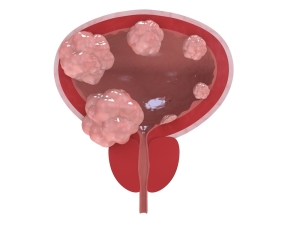Like with other cancers, physicians developed a staging system for bladder cancer staging. Other staging systems were in use in the past, but the recommendation now is to use the TNM staging developed by the International Union Against Cancer.
Stage of bladder cancer (TNM classification)
Tis : carcinoma in situ (localized in one spot)
T1 : invades the tissue layer under the lining of the bladder wall
T2 : invades the muscle layer of the bladder, not palpable
T3a : invades deep the muscle layer, it is palpable
T3b : invasion into fat layer around bladder
T4 : extension into surrounding organs (prostate or vagina, rectum, bony pelvis or abdominal wall)
This was adopted by the American Joint Committee. “T” stands for “tumor”, “N” for lymph “node” metastasis and “M” for distant “metastasis”. There are subclassifications for each of these categories so that the spread of the cancer can accurately be described.
The tabulation above contains a brief description of the TNM system for bladder cancer; the image below shows the extent of invasion for various stages of bladder cancer.
TNM classification of bladder cancer
This is only a rough overview as it does not show the involvement of lymph nodes and does not list the number of distant metastases. A full report of the TNM classification would contain all of this information. However, for the purposes of this summary it suffices to say that there would not be any lymph node metastases or distant metastases in a Tis or T1 stage.
However, in the T2 stage of bladder cancer it would have spread into 10 or 20 regional lymph glands. There might also be 1 or 2 distant metastases (paraaortic nodes for instance). With a stage T3a there might be 20 lymph nodes affected and 10 distant metastases as well. With theT3b stage there might be 50 positive nodes and 60 more distant metastases, most of them likely in the paraaortic nodes.
More advanced stages of bladder cancer
Sometimes it is difficult to know whether or not a distant metastasis was missed in this stage, as in this case it would be more correctly labeled as T4 stage. This stage is assigned to those cases of bladder cancer where the tumor has eaten its way through the entire bladder wall and spread to one or more neighboring organs or else has metastasized to distant sites such as lungs, brain, bone etc.
We learnt with other cancers that the staging information is important for making predictions regarding the survival chances (prognosis). I also have pointed out earlier that histology, grade and certain genetic information from the cancer cells are important. All of this information is now put together in an attempt to improve the outlook for the patient. The 5-year survival for bladder cancer is shown under the link “Bladder Cancer Treatment” under “Related Topics” below.
References
1. Cancer: Principles&Practice of Oncology. 5th edition, volume 1. Edited by Vincent T DeVita, Jr. et al. Lippincott-Raven Publ., Philadelphia,PA, 1997.
2. Cancer: Principles &Practice of Oncology, 4th edition, by V.T. De Vita,Jr.,et al. J.B. LippincottCo.,Philadelphia,1993.Chapter 34, page 1054 (data from text arranged as a table).
3. M Simoneau et al. Oncogene 2000 Dec 19(54): 6317-6323.
4. G Dalbagni , HW Herr Urol Clin North Am 2000 Feb 27(1): 137-146.
5. HW Herr J Clin Oncol 2001 Jan 1;19(1): 89-93.
6. DA Corral, CJ Logothetis World J Urol 1997; 15(2): 139 – 143.
7. PM Dodd et al. J Clin Oncol 1999 Aug;17 (8): 2546- 2552.
8. B. Sears: “The age-free zone”.Regan Books, Harper Collins, 2000.
9. Conn’s Current Therapy 2004, 56th ed., Copyright © 2004 Elsevier
10. Ferri: Ferri’s Clinical Advisor: Instant Diagnosis and Treatment, 2004 ed., Copyright © 2004 Mosby, Inc







